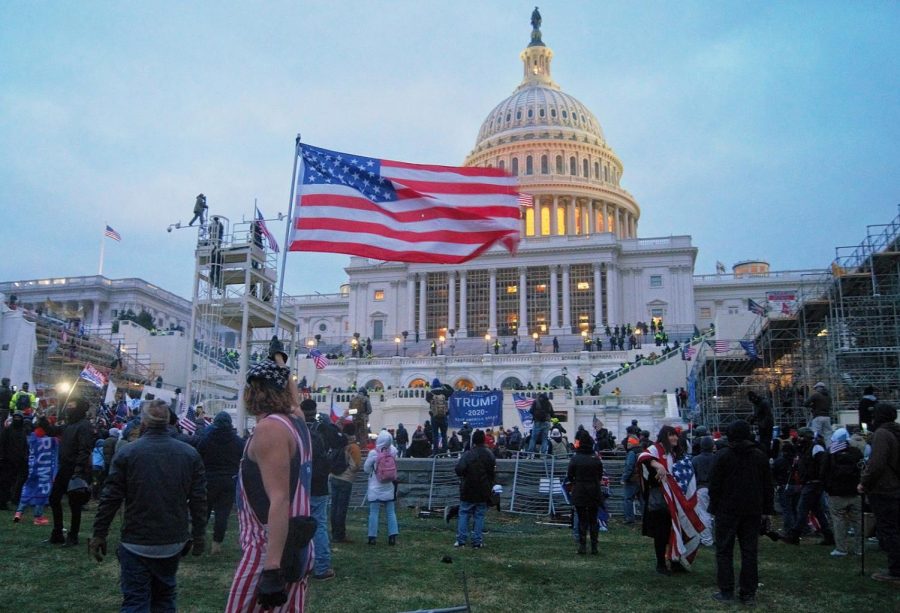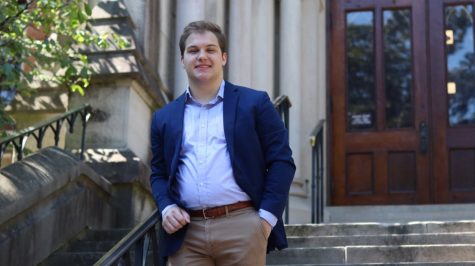What America First Really Meant
January 22, 2021
An IED sat on the hill of the nation’s capital ready to hasten an already devolving Washington D.C. on the route to chaos. Windows of a Capitol room shattered from the impact of a riot shield as legislators in the nearby chambers strapped on gas masks and cowered under their desks. Far from an isolated incident, the attack on the Capitol on January 6, 2021 was the natural outcome of four years of disinformation and anger at the existing political system. This was America First at its core.
Initially, invoked by Donald Trump during his 2016 presidential campaign, “America First” was a pledge to end the “forever wars” in the Middle East that his predecessors had maintained, with a promise to instead return the focus of U.S. government policy to American workers. Accordingly, he promised to renegotiate trade deals that he claimed allowed other nations to take advantage of the United States. Trump’s “America First” was not a new sentiment in American politics. “America First” was first used as a slogan in opposition to U.S. involvement in World War II, and the America First Committee (AFC) was founded in 1940. AFC member Charles Lindbergh would traffic in nativism and isolationism, which contended that America’s interests should be placed above the interests of the rest of the world. In Trump, these isolationist and nativist perspectives found a place at the forefront of American politics once again.
It was with this agenda that Trump patchworked his culture in America. One that harkened history’s door with knocks of nativism and conspiracy. In what Richard Hofstadter deemed the “paranoid style,” Trump injected a portion of the American population with the disease of hatred that populism can breed. The paranoid style is a tactic of political leaders that relies on paranoid conspiracies to convince their followers that the rest of the world is engaged in hostile conspiracies to harm their nation and its culture. According to Hofstadter, this is not a people suffering from clinical paranoia, but a group utilizing paranoid expressions. Trump, in this style, convinced many Americans that coastal elites were conspiring to oppress them and that the Democratic Party was a force of socialism that would take their guns, their jobs, and even their windows.
America First wasn’t about fighting or making peace in the wars abroad, it was about deepening the culture war at home. It was never Republicans versus Democrats. Nor was it America versus China, Iran, or any other foreign entity. It has always been MAGA versus everyone else. America First was about what Trump and MAGA wanted, but, more importantly, it was also about creating a cult of grievances. The right-wing of American politics has been engulfed in a battle with itself, not about ideology, but about the need to justify feeding the desires of one group by creating the impression that the rest of the world is out to stop them.
Trump didn’t merely unleash a force at the ballot box. Trump unleashed a movement that resembled the cult of personality that surrounds authoritarian leaders. Like an attack dog, Trump could sick these followers onto seemingly whatever he wanted. But the spell wasn’t as broad-reaching as many assumed. When Senators David Perdue and Kelly Loeffler needed Trump’s base in Georgia on January 5th, they didn’t match their turnout from November. This dropoff illustrated that Trump’s disenchantment with other members of the Republican Party, most notably his break with Senate Majority Leader Mitch McConnell on $2,000 stimulus checks, further alienated Trump’s base from other candidates in the Republican Party. Trump’s allegation that Georgia rigged the presidential election in November also didn’t serve to elevate turnout of his base. Many of Trump’s voters are aligned with his interests and their focus was on objecting to the election certification on January 6th, instead of maintaining a Senate majority in the election on January 5th.
While some of Trump’s supporters and political allies slowly turn away from the past four years, Trump’s base is not concerned with the realities of a loss. The cult of personality that surrounds Trump enabled him to mobilize a base that loved him so dearly that, in their eyes, he could do no wrong. If Trump failed, it was due to a conspiracy by Democrats, the Clintons, or even the “Deep State” in American government. For example, Trump and some of his supporters claimed that former President Barack Obama led the special counsel investigation of Russian collusion in the 2016 Election. Trump’s challenge to the Electoral Certification was about creating another us-versus-them scenario. Trump’s speech prior to the insurrection on January 6th was not about the preservation of Republicans or his allies. Donald Trump Jr. warned Republicans who didn’t object, “We’re coming for you.” Donald Trump threatened Vice President Mike Pence, stating, “Mike Pence is going to have to come through for us, and if he doesn’t, that will be a sad day for our country.” Trump’s objection was about saving himself from a loss and it was further proof that MAGA does not see itself as a perpetrator against American democracy, but a victim of it.
A politics of exclusion has created a sense of belonging for one small group that is both “loved” and “special” to its bearer. This is not an ideology; MAGA and its siblings are a cultural identity created by the paranoid message that the world is about one group against all others. Trump created an identity that sulked in its victimization at the hands of elites like the man who breathed life into them: Trump. However, Trump would be their enlightened despot and free them from their oppressors. MAGA and America First were about tapping into the desperation and victimization that would enable a man to become infallible and a democracy to become untenable.
Many wonder how America got here, but America has been here before. The end of Trump and a potential ending of Trumpism will not be the ending of this paranoid style. Trump merely added his name to the historical list of practitioners including Joseph McCarthy’s Communist Crusade, Barry Goldwater’s anti-intellectualism, and George Wallace’s racist populism. We have not yet seen the ending of the paranoid style, merely its return from the frays of American politics.
Image Credit: “2021 storming of the United States Capitol” by Tyler Merbler is licensed CC BY-SA 2.0








